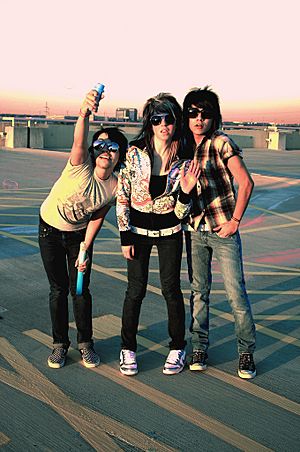Slim-fit pants facts for kids
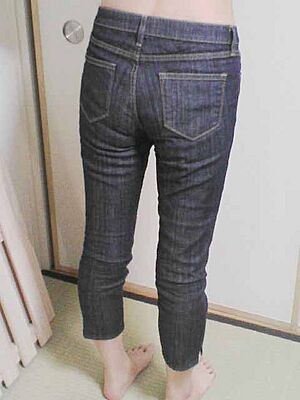
Slim-fit pants or skinny jeans are a type of pants that fit very closely to your legs. They are tight all the way down to your ankles. When they are made of denim fabric, they are called skinny jeans.
These pants have many other names, like drainpipes, stovepipes, tight pants, cigarette pants, and pencil pants. Skinny jeans get narrower at the very bottom. Drainpipe jeans are also skinny, but the lower part of the leg is straight. This means they can be a bit looser at the ankle than skinny jeans.
Sometimes, these pants have zippers at the bottom. These zippers help you pull the pants over your feet easily. Many skinny jeans are made with stretchy denim. This denim often has a small amount of spandex (a stretchy material). This makes the jeans super-slim and comfortable. Skinny jeans come in many different colors and styles.
Contents
History of Skinny Pants
Early Styles
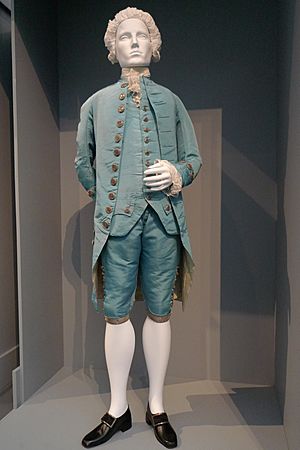
Before the 1700s, men in Europe wore breeches and hose. Breeches were loose at first. But by the 1660s, tight breeches became popular. Frenchmen at the court of King Louis XIII helped make them famous. They were part of a fancy three-piece suit.
These tighter breeches came to England and other parts of Europe. People thought they made legs look better.
In India, from the 1500s to the 1800s, noble people wore tight-fitting Churidars. These trousers were tied below the knee. English people working in India, like those from the East India Trading Company, sometimes wore these traditional clothes.
The 1800s: Pantaloons
Tight pants were fashionable from 1805 to 1850. They came from the loose work trousers worn by ordinary people during the French Revolution. These new "pantaloons" became popular with stylish English gentlemen like Beau Brummell.
Pantaloons sat high on the waist. They were made to show off the legs, much like the breeches before them. People often tied or buttoned pantaloons around the ankle. They were commonly worn tucked into boots.
A Looser Look: 1890s to 1940s
After the 1840s, pants started to fit more loosely. This was because clothes began to be made in factories, not just by tailors. In the early 1900s and into the 1920s, very baggy "Oxford" trousers and plus fours became popular. These were favored by younger people. Oxford bags started at universities in the UK. Young men there enjoyed sports and an active life.
The 1950s Comeback
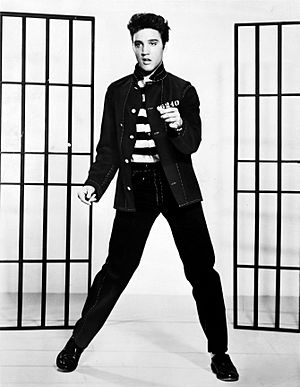
Drainpipe trousers became popular again in the 1950s. Famous Western movie stars wore them. These included singing cowboy Roy Rogers and The Lone Ranger. Actresses like Marilyn Monroe also wore very slim pants.
Tapered jeans became very noticeable with country music stars. They also became a big part of rock and roll fashion. When Elvis Presley wore slim-fitting jeans, it was a big surprise to many people.
The 1960s Style
In the early 1960s, many rock bands wore drainpipes. These included The Beatles, The Rolling Stones, and Bob Dylan. Fashion icon Audrey Hepburn also helped make drainpipe jeans more popular.
Slim pants and jeans were worn by teenagers in the Mod or greaser subculture. But ordinary people wore them too. By 1962, stores like Sears sold tight jeans made from "stretch" denim. This denim had elastane (another stretchy material). This trend lasted until the late 1960s. Then, "hippie" culture brought in flared and bell bottom jeans.
The 1970s and Punk
In the early 1970s, glam rock and rockabilly bands brought back drainpipe jeans. This was different from the flared pants that hippies wore. Red tartan drainpipe jeans were very popular in the punk subculture of the late 1970s. Many punk bands wore them, like Ramones, The Clash, and Sex Pistols.
The 1980s Look

Skin-tight acid-washed jeans were also popular in the 1980s. Many heavy metal bands wore them. This was especially true for bands in the thrash metal scene, like Anthrax and Metallica. These jeans were an alternative to spandex, which was also popular then.
People often wore them with white high-top sneakers or basketball shoes like Converse. By the late 1980s, straight leg jeans became more common. But drainpipe pants stayed popular with hard rock fans until the 1990s. Pop stars like Michael Jackson and Freddie Mercury also wore tight jeans.
The 1990s Shift
By the early 1990s, some glam metal bands started wearing form-fitted jeans instead of spandex. Tight jeans were also worn by people in the casual subculture until the mid-1990s.
However, in the mid-1990s, grunge and hip-hop music became very popular. This led to a quick change in fashion. Drainpipe jeans went out of style. Baggy carpenter jeans became popular, worn by hip-hop artists like Snoop Dogg. Flared jeans also came back, moving fashion away from the tight drainpipe style.
The 2000s Return
In the early and mid-2000s, slim-fitting pants were not popular in mainstream fashion. But in 2005, "skinny jeans" were brought back for women. At first, you could only buy them online. People were not sure about them.
But by 2006, skinny jeans started to gain popularity. They began to be sold in shopping malls. In 2007, skinny jeans became even more popular. Fashion trends moved away from bell bottoms and baggy pants, which had been popular for ten years. Men's skinny jeans were introduced in 2008 and became common by 2009.
The 2010s and Beyond
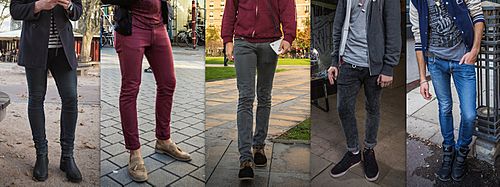
Skinny jeans became popular in men's fashion around 2008. This trend continued into the 2010s, becoming mainstream in 2011. Since then, skinny jeans have remained very popular. They became one of the most important fashion items of the decade for both men and women.
Many men also started wearing tight-fitting chino trousers in different colors. These often came in khaki, brown, or white. For women, the high-waist trend came back into style for skinny jeans. Women's skinny jeans also came in many colors, often neutral ones like khaki and white.
In Europe, skinny jeans for boys and men sometimes have a looser waist. This makes them look a bit "baggy" at the top, but still skinny on the legs.
See also
 In Spanish: Pantalón pitillo para niños
In Spanish: Pantalón pitillo para niños



